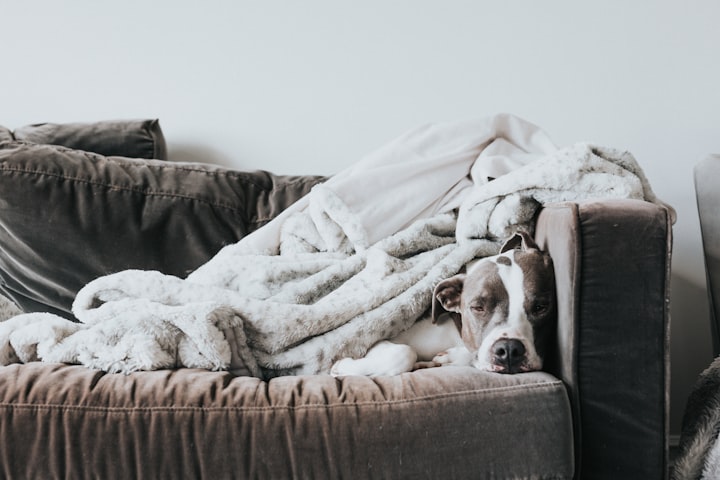Managing Destructive Behavior in Dogs: Tips and Solutions
Creating a Peaceful Home Environment for Your Canine Companion

Destructive behavior in dogs, such as furniture destruction, can be frustrating for pet owners. It is important to understand that destructive behavior may be a symptom of underlying issues, such as separation anxiety. In this blog, we will explore the causes of destructive behavior, focusing on separation anxiety, and provide tips and solutions to help address this problem. By implementing the following strategies, you can create a harmonious living environment for both you and your beloved canine companion.
Understanding the Causes:
Destructive behavior in dogs can stem from various factors, including boredom, lack of exercise, inadequate mental stimulation, fear, or anxiety. Separation anxiety is a common trigger for destructive behavior, as dogs may resort to chewing or scratching furniture in an attempt to cope with their distress when left alone. Identifying the underlying cause of destructive behavior is crucial in developing effective solutions.
Exercise and Mental Stimulation:
Regular exercise and mental stimulation are vital for a dog's well-being. Engaging in physical activities such as daily walks, jogging, or playing fetch can help burn off excess energy. Additionally, mental stimulation through interactive toys, treat puzzles, or training sessions can keep your dog occupied and mentally challenged. Providing these outlets for physical and mental exercise can reduce the likelihood of destructive behavior.
Create a Safe Space:
Creating a safe and comfortable space for your dog can alleviate anxiety. Set up a designated area, such as a crate or a specific room, where your dog feels secure and has access to their bed, toys, and water. Gradually introduce this space and associate it with positive experiences, like treats or favorite toys. By offering a safe haven, you provide your dog with a sense of security and reduce the likelihood of destructive behavior.
Gradual Desensitization:
For dogs with separation anxiety, desensitization techniques can be highly effective. Start by practicing short departures and gradually increase the duration over time. Begin by leaving for just a few minutes and returning before your dog becomes anxious. Reward your dog for calm behavior and gradually extend the time you're away. This gradual exposure helps your dog build confidence and reduces their anxiety when left alone, thus minimizing destructive behavior.
Counterconditioning:
Counterconditioning involves associating positive experiences with situations that trigger anxiety. Use treats, toys, or other rewards to create positive associations with departures. For example, offer a special treat or a puzzle toy filled with treats exclusively when you leave the house. This positive reinforcement helps your dog view your departure as a positive experience rather than a trigger for anxiety, thereby reducing destructive behavior.
Consistency and Positive Reinforcement:
Consistency and positive reinforcement are key factors in managing destructive behavior. Establishing a consistent routine and enforcing clear boundaries helps your dog understand what is expected of them. When your dog exhibits appropriate behavior, reward them with praise, treats, or playtime. Consistency in your reactions to their behavior, both positive and negative, will help them learn what is acceptable. Avoid punishing or scolding your dog for past destructive acts, as this may confuse them and create additional anxiety. Instead, focus on redirecting their attention to appropriate outlets for their energy and providing positive reinforcement for desired behaviors.
Professional Help
If the destructive behavior persists despite your best efforts, seeking professional help from a vet or a certified dog behaviorist is advisable. They can conduct a thorough assessment of your dog's behavior and provide tailored guidance to address the underlying issues. Professional intervention may include behavior modification techniques, medication (if necessary), or additional support to help your dog overcome separation anxiety and destructive behavior.
Conclusion:
Dealing with destructive behavior in dogs requires patience, consistency, and understanding. By addressing the root causes, such as separation anxiety, and implementing the suggested tips and solutions, you can significantly reduce furniture destruction and create a more harmonious home environment. Remember to provide adequate exercise, mental stimulation, and a safe space for your furry friend. With time, patience, and the right approach, you can help your dog overcome destructive behavior and strengthen the bond between you both.
Learn more ways to care for your dog Click Here Now!
About the Creator
Big Dog Shopping
Big Dog Shopping was created with the needs of big dog parents in mind. We understand the challenges of finding products that are suitable for larger breeds. We featuring only the highest quality products.





Comments
There are no comments for this story
Be the first to respond and start the conversation.